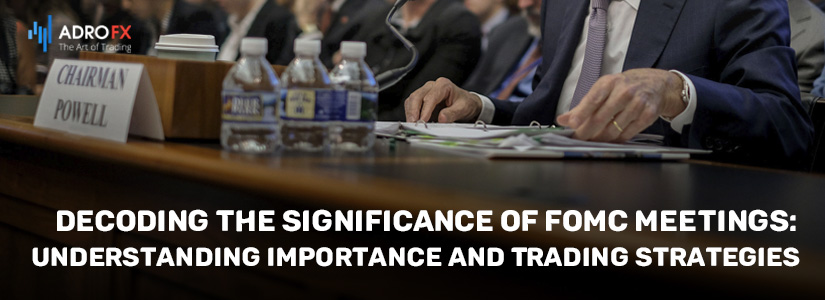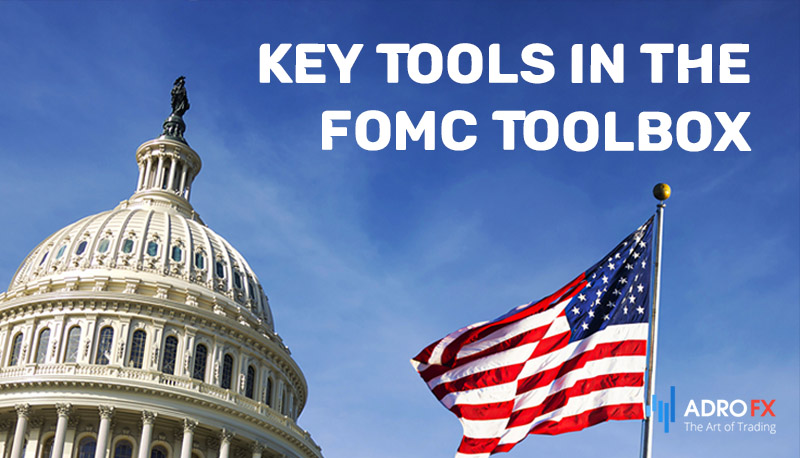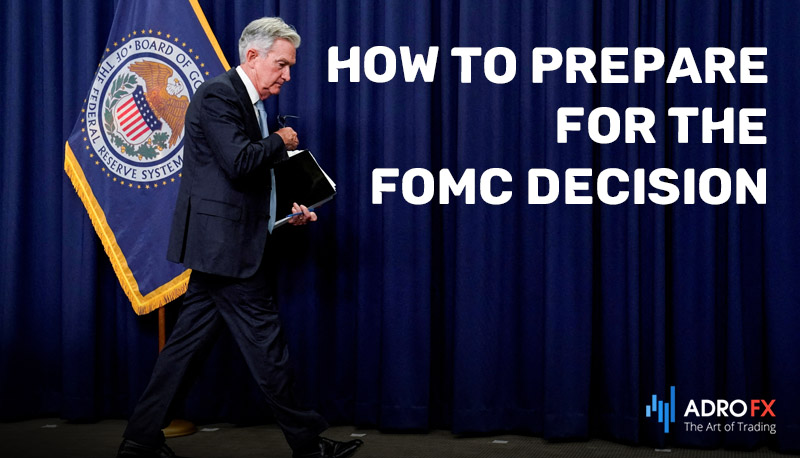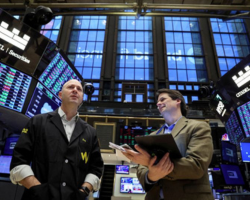Decoding the Significance of FOMC Meetings: Understanding Importance and Trading Strategies

In the intricate web of global financial markets, few events hold as much sway over investor sentiment and market dynamics as the Federal Open Market Committee (FOMC) meetings. These gatherings, conducted by the United States Federal Reserve, transcend the realm of routine policy discussions. They wield the power to set the tone for economic growth, interest rates, and the overall direction of financial markets not only in the United States but also reverberating across the globe. Understanding the pivotal role of FOMC meetings and navigating their outcomes with insightful trading strategies are essential pursuits for investors and traders alike.
This article delves into the core significance of FOMC meetings, unraveling the intricate factors that make these events so crucial for financial markets. From deciphering the language of central bank communications to comprehending the far-reaching impact of interest rate decisions, we will explore why FOMC meetings consistently rank among the most anticipated events on investors' calendars.
Whether you're a seasoned trader seeking to refine your approach or a newcomer aiming to grasp the complexities of central bank influence, this article equips you with the insights needed to comprehend why FOMC meetings hold a position of paramount importance and how you can tactically engage with these events in the ever-evolving landscape of global finance.
What Is the FOMC?
The FOMC stands for the Federal Open Market Committee. It is a key component of the United States Federal Reserve System, which is the country's central banking system. The FOMC plays a crucial role in the formulation of monetary policy in the United States.
The FOMC is responsible for making decisions related to interest rates and other monetary policies that affect the economy. One of its primary objectives is to maintain price stability and promote sustainable economic growth. To achieve these goals, the FOMC has the authority to set the target range for the federal funds rate, which is the interest rate at which banks lend funds to each other overnight.
The committee is composed of voting members, which include the seven members of the Board of Governors of the Federal Reserve System and five of the twelve regional Federal Reserve Bank presidents. The President of the Federal Reserve Bank of New York is always a voting member, while the other four regional presidents serve on a rotating basis. Additionally, there are non-voting Reserve Bank presidents who participate in the discussions and deliberations.
The FOMC meets regularly to assess economic conditions, review financial market developments, and discuss potential policy actions. Their decisions can have a significant impact on various aspects of the economy, including borrowing costs, consumer spending, business investment, and overall economic growth. As such, the FOMC's actions and statements are closely monitored by financial markets, economists, and policymakers around the world.

Is the Fed the Same as the FOMC?
No, the Federal Reserve (often referred to simply as the "Fed") and the Federal Open Market Committee (FOMC) are not the same, but they are closely related.
The Federal Reserve (or the Fed) is the central banking system of the United States. It was established to provide the country with a safe, flexible, and stable monetary and financial system. The Fed has several important functions, including conducting monetary policy, supervising and regulating banks, maintaining the stability of the financial system, and providing various financial services to banks and the government.
The Federal Open Market Committee (FOMC) is a part of the Federal Reserve System. It is specifically responsible for formulating the monetary policy of the United States. The FOMC is composed of members from the Board of Governors of the Federal Reserve and the presidents of several regional Federal Reserve Banks. The committee meets regularly to assess economic conditions, discuss policy options, and make decisions regarding key aspects of monetary policy, such as setting the target range for the federal funds rate.
In essence, the FOMC operates within the framework provided by the broader Federal Reserve System. While the Federal Reserve has a wider range of functions, the FOMC's primary focus is on making decisions that influence interest rates and currency in circulation to achieve the Fed's dual mandate of promoting price stability and maximum sustainable employment.

Key Tools in the FOMC Toolbox
The Federal Open Market Committee (FOMC) utilizes a variety of tools to implement monetary policy and achieve its objectives of promoting price stability and maximum sustainable employment. Some of the key tools in the FOMC's toolbox include:
- Open Market Operations: This is the primary tool used by the FOMC to influence short-term interest rates and control the cash reserve. Through open market operations, the FOMC buys or sells U.S. Treasury securities in the open market. When the FOMC buys securities, it injects funds into the banking system, leading to lower interest rates. Conversely, when it sells securities, it reduces the cash flow and leads to higher interest rates.
- Federal Funds Rate Target: The FOMC sets a target range for the federal funds rate, which is the interest rate at which banks lend reserves to each other overnight. By adjusting this target rate, the FOMC influences broader interest rates throughout the economy. If the FOMC wants to stimulate economic activity, it might lower the target rate, making borrowing cheaper. If it wants to combat inflation, it might raise the target rate to make borrowing more expensive.
- Discount Rate: The discount rate is the interest rate at which banks can borrow funds directly from the Federal Reserve. By changing the discount rate, the Fed can encourage or discourage banks from borrowing directly from it. Changes in the discount rate can have a trickle-down effect on other interest rates in the economy.
- Forward Guidance: The FOMC communicates its intentions and future policy actions to the public and financial markets through forward guidance. This involves indicating how it expects to adjust interest rates or other policy tools based on its assessment of economic conditions. Forward guidance helps shape market expectations and influences borrowing and spending decisions.
- Asset Purchases (Quantitative Easing): During times of economic stress or when traditional policy tools are limited, the FOMC might engage in quantitative easing (QE). This involves purchasing longer-term assets like government bonds and mortgage-backed securities to lower long-term interest rates and stimulate economic activity.
- Balance Sheet Management: The FOMC can adjust the size and composition of its balance sheet by buying or selling assets. This tool was particularly prominent during and after the global financial crisis when the Fed engaged in large-scale asset purchases to support the economy.
- Inflation Targeting: While not a direct tool, the FOMC's explicit inflation target is an important aspect of its policy framework. The FOMC aims for 2% inflation over the longer run, and its policy decisions are influenced by its assessment of inflation trends.
These tools are used in combination to influence the currency in circulation, interest rates, and overall economic activity. The FOMC assesses economic conditions and adjusts its policy stance based on its goals of maintaining stable prices and promoting maximum employment.
How the FOMC Meeting Decisions Affect Trading
The decisions made during Federal Open Market Committee (FOMC) meetings can have significant effects on trading across various financial markets due to their influence on interest rates, market expectations, and investor sentiment. Here's how FOMC meeting decisions can impact trading:
- Interest Rates: One of the most direct impacts of FOMC decisions is on interest rates, especially the federal funds rate and short-term rates. If the FOMC decides to raise interest rates, it can lead to higher borrowing costs for businesses and consumers. This can reduce spending and borrowing, potentially slowing down economic activity. Conversely, if the FOMC decides to lower interest rates, it can stimulate borrowing and spending, which might boost economic growth.
- Bond Markets: FOMC decisions affect the bond markets significantly. When the FOMC raises interest rates, the yields on newly issued bonds tend to rise as well. This can lead to a decrease in demand for existing bonds with lower yields, causing their prices to fall. On the other hand, when the FOMC lowers rates, it can lead to higher demand for existing bonds, causing their prices to rise.
- Equity Markets: Stock markets are sensitive to changes in interest rates and overall economic conditions. If the FOMC raises rates, it can lead to higher borrowing costs for companies, potentially impacting corporate earnings. This could lead to lower stock prices as investors reassess the potential returns from equities compared to fixed-income investments. Conversely, when the FOMC lowers rates or adopts an accommodative stance, stock markets might respond positively due to the expectation of improved economic conditions and lower borrowing costs.
- Currency Markets: FOMC decisions can influence currency exchange rates. When the FOMC raises rates, it can attract foreign capital seeking higher yields, potentially appreciating the value of the U.S. dollar. Conversely, lower rates might lead to a weaker dollar as investors seek higher yields elsewhere.
- Commodity Markets: Commodity prices can be affected by FOMC decisions. If the FOMC raises rates and tightens monetary policy, it could lead to a stronger dollar, which might put downward pressure on commodity prices. Conversely, looser monetary policy might weaken the dollar and support higher commodity prices.
- Market Volatility: FOMC meetings are events that generate significant market attention and can lead to increased volatility. Traders and investors closely follow the statements and decisions from the FOMC meetings to gauge the future direction of monetary policy. Sudden shifts in policy expectations or surprises in the decisions can lead to sharp market movements.
- Market Sentiment and Expectations: FOMC meetings can shape market sentiment and expectations. The language used in the FOMC's statements, along with forward guidance on future policy actions, can impact how investors perceive the trajectory of the economy and markets. Changes in sentiment can influence trading decisions and market behavior.
Overall, FOMC meetings are closely monitored by traders and investors across different asset classes. The decisions and statements made during these meetings can lead to immediate market reactions as well as longer-term shifts in investment strategies based on the expected impact of monetary policy on the economy and financial markets.

How to Prepare for the FOMC Decision
Preparing for Federal Open Market Committee (FOMC) decisions involves staying informed about economic indicators, understanding market expectations, and being ready to react to potential market movements. Here are some steps to help you prepare:
Stay Informed:
- Follow economic indicators: Pay attention to key economic indicators such as GDP growth, inflation, employment data, and consumer sentiment. These indicators can provide insights into the health of the economy and influence FOMC decisions.
- Monitor central bank communication: Keep an eye on statements, speeches, and interviews by Federal Reserve officials leading up to the FOMC meeting. These can offer hints about their views on the economy and potential policy moves.
Understand Market Expectations:
- Study market forecasts: Analyze market expectations for interest rate changes, policy stance, and economic projections. Financial instruments like Fed funds futures and interest rate swaps can provide insights into market expectations for rate movements.
- Review economic forecasts: Research the consensus economic forecasts for key indicators. This can help you gauge how closely the FOMC's decisions align with market expectations.
Assess Potential Scenarios:
- Consider different outcomes: Prepare for various scenarios, such as a rate hike, rate cut, or no change in rates. Think about how each scenario could impact different asset classes and sectors of the economy.
- Identify sensitive markets: Identify markets that are likely to be most affected by the FOMC decision, such as interest rate-sensitive assets like bonds, currencies, and stocks.
Risk Management:
- Set risk parameters: Determine your risk tolerance and set stop-loss levels for trades that might be impacted by FOMC decisions. This helps you manage potential losses in case of unexpected market movements.
- Diversify your portfolio: Spread your investments across different asset classes to reduce the impact of a single market's volatility on your overall portfolio.
Stay Updated:
- Monitor news feeds: Stay connected to reliable news sources that provide real-time updates on FOMC decisions, statements, and related market movements.
- Use economic calendars: Consult economic calendars to know when FOMC meetings are scheduled, as well as other important economic releases that could affect market sentiment.
Be Ready to Act:
- Plan trading strategies: Develop trading strategies based on different scenarios and potential market reactions. Consider both short-term and long-term implications.
- Keep trading platforms ready: Ensure your trading platforms are functional and ready for execution in case you need to make quick trading decisions.
Maintain Flexibility:
- Be adaptable: Be prepared to adjust your trading strategies based on new information or unexpected market developments that might arise during the FOMC decision.
- Avoid impulsive decisions: While being prepared is important, avoid making impulsive trading decisions based solely on short-term market movements. Stick to your well-thought-out strategies.
Remember that FOMC decisions can lead to increased market volatility, and trading during these times can carry higher risks. It's important to have a well-defined plan, manage your risk, and be prepared for various outcomes. If you're unsure about how to navigate FOMC-related trading, consider seeking advice from financial professionals or experienced traders.
Final Thoughts
In the intricate global financial landscape, few events rival the impact of Federal Open Market Committee (FOMC) meetings. These gatherings by the US Federal Reserve wield immense power, shaping economic growth, interest rates, and market directions, both domestically and globally.
This article has delved into the core significance of FOMC meetings, decoding their language and highlighting their impact on various markets. It's clear that deciphering FOMC meetings is vital for traders and investors. The tools at the FOMC's disposal, such as open market operations and interest rate targeting, now hold no secrets.
The influence of FOMC decisions on trading across markets is unmistakable. From interest rates and bonds to equities, currencies, and commodities, the effects reverberate widely. Thus, preparing for FOMC outcomes requires staying informed, understanding market expectations, and planning for potential scenarios.
In conclusion, FOMC meetings epitomize financial influence and call for proactive engagement. Armed with insights from this article, we can approach these events as informed participants, capable of understanding policy nuances, navigating market shifts, and capitalizing on emerging opportunities.
About AdroFx
Established in 2018, AdroFx is known for its high technology and its ability to deliver high-quality brokerage services in more than 200 countries around the world. AdroFx makes every effort to keep its customers satisfied and to meet all the trading needs of any trader. With the five types of trading accounts, we have all it takes to fit any traders` needs and styles. The company provides access to 115+ trading instruments, including currencies, metals, stocks, and cryptocurrencies, which make it possible to make the most out of trading on the financial markets. Considering all the above, AdroFx is the perfect variant for anyone who doesn't settle for less than the best.










